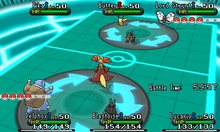Pokémon battle: Difference between revisions
m (→In the anime) |
m (Tepig) |
||
| Line 38: | Line 38: | ||
===In the anime=== | ===In the anime=== | ||
[[File:Pokabu Tsutarja Battle.png|thumb|220px|right|A battle between [[Ash's | [[File:Pokabu Tsutarja Battle.png|thumb|220px|right|A battle between [[Ash's Tepig]] and a wild Tsutarja about to begin.]] | ||
In the anime, the progression of battle is slightly different. An expansion on the games' concept, the anime's battles are more free-flowing than those in the games, with opposing Trainers being able to block and evade moves in different and more creative ways than the games allow for, invent their own moves as combinations of other moves, and so on. Several concepts that later became standard in the games were developed in the anime, such as the {{a|Lightningrod}} ability and double battles. | In the anime, the progression of battle is slightly different. An expansion on the games' concept, the anime's battles are more free-flowing than those in the games, with opposing Trainers being able to block and evade moves in different and more creative ways than the games allow for, invent their own moves as combinations of other moves, and so on. Several concepts that later became standard in the games were developed in the anime, such as the {{a|Lightningrod}} ability and double battles. | ||
Revision as of 04:41, 23 November 2010

A Pokémon battle (Japanese: ポケモンバトル Pokémon battle) is a form of competition between Pokémon. In these battles, one or more of the Pokémon is typically owned and trained by a person, its Pokémon Trainer, in order to win.
When a Pokémon faints in battle, its Trainer may send out another to take its place. After all of a Trainer's party Pokémon have been defeated, the battle has been won, and the loser must pay out some amount of money to the winner, determined based on the level of the Pokémon and type of Trainer defeated. In the main series games, if the player's Pokémon have all been defeated, he or she will black out (Generation I and Generation IV) or white out (Generation II and Generation III), and be teleported back to the most recent Pokémon Center that was visited, or to his or her home, if a Pokémon Center has not yet been visited.
Pokémon battles appear in most forms of Pokémon media, being the central gameplay aspect of the main series games, as well as being a constant focus of the anime. Typically, a Pokémon battle will be a one-on-one fight between two Pokémon, however, variations on this model have been seen since early on in the series, with Pokémon battles featuring multiple Pokémon on each side later being implemented in the games as well.
Progression of battle
A Pokémon battle will progress in a turn-based system in the games, and in a somewhat turn-based manner in the anime and other media. In the games, the progression of the turns depends on the selected command and the Speed of the Pokémon on each side.
In the games
In the games, the main battle screen will have four options: Fight, Bag, Pokémon, and Run. Depending on which of these is selected, a different menu will appear, or the battle may end. These same four options will appear no matter what kind of battle the player is in, be it with a wild Pokémon, an NPC, or another player via link battle.
Fight
Selecting "Fight" will bring up another menu which allows the player to choose which of his or her Pokémon's current moves is to be used during the turn. Depending on its remaining PP, a move may or may not be able to be selected; at least 1 PP is required to select the move.
Once the move has been selected, the Pokémon currently in battle will make each of their moves in turn, with the Pokémon with the highest Speed stat going first, and the one with the lowest Speed stat going last. Depending on the moves used, items held by individual Pokémon, and status conditions, this progression may be altered, with moves like Quick Attack having an increased priority and items like the Iron Ball slowing down the Pokémon that holds it.
As each Pokémon makes its move, a Pokémon may faint if its HP reaches 0. If this occurs, another Pokémon must be switched in to replace it in battle for the battle to continue. This switch occurs before the turn ends in Generations I, II, and III, but after the end of the turn in Generation IV, resulting in a slightly different strategy for double battles between Generation III and Generation IV.
Bag
- Main article: Bag
If "Bag" is selected, it will bring up the contents of the player's bag on screen. In Generation I, this command is instead "Item", as in the overworld. In Generations I, II, and III, the bag menu that is brought up is the same as that in the overworld, with all of a player's items able to be selected (though many cannot be used). Generation IV instead features a separate menu for in-battle use that categorizes the items that the player has depending on their use. If an item is selected to be used, this will take place before any Pokémon makes its move, and the player's Pokémon will not be able to make a move. The Bag selection is sometimes disabled, most notably in link battles and during Battle Frontier competitions.
Pokémon
- Main article: Party
Selecting "Pokémon" will bring up a menu of the player's current party Pokémon, allowing them to be checked by the player or switched into battle, sending the player's active Pokémon back into its Poké Ball. As with the bag, the Pokémon menu screen is exactly the same as that in the overworld in Generations I, II, and III, with differences in usable commands, while different in Generation IV, featuring only battle-relevant data.
Run
- Main article: Escape
If "Run" is selected, the player will attempt to escape from the battle. Battles against NPC Trainers cannot be run from except in a Battle Frontier facility, while battles against other players can be run from at any time, resulting in a loss (if only one player runs) or a draw (if both players run). This option, like Fight, also depends on the Speed of the Pokémon in battle, with a calculation made based on the two resulting in either the player escaping a wild battle (if the player's Pokémon's Speed is high enough) or being stuck in battle and losing a turn. Trapping moves can prevent escape attempts from being made, as can the player's own Pokémon if it has previously used Ingrain.
In Pokémon Colosseum and Pokémon XD: Gale of Darkness, this option is replaced by a "Call" option, which allows the player to return a Shadow Pokémon from Hyper Mode and Reverse Mode or wake it up from sleep. It can also be used to simply pass a turn, and in XD, will raise the Accuracy of a non-Shadow Pokémon who is not asleep by one level.
In the anime
In the anime, the progression of battle is slightly different. An expansion on the games' concept, the anime's battles are more free-flowing than those in the games, with opposing Trainers being able to block and evade moves in different and more creative ways than the games allow for, invent their own moves as combinations of other moves, and so on. Several concepts that later became standard in the games were developed in the anime, such as the Lightningrod ability and double battles.
Unlike the games, there will often be a referee who determines whether or not a Pokémon is able to continue the match, as there is not the strictly-programmed HP limit. This referee will sometimes be a Pokémon League official, especially in matches conducted in the various leagues' tournaments, though informal battles can be conducted with either no referee at all or with a knowledgeable person serving as the ref. Brock has served as the referee for many of the informal matches between Ash and the many people he has met along his journey.
Battles in the anime often feature a limit to the amount of Pokémon that can be used: Trainers rarely are allowed to use their full party of six, and must instead choose which members they will use. Switching a Pokémon out in some instances is counted the same as the Pokémon fainting. Most Gym Leaders and other elite Trainers will not switch their Pokémon when challenged, as well, but will allow the challenger to do so.
In Pokémon Adventures
Pokémon battles in the Pokémon Adventures manga are arguably the most violent incarnation of battles in any Pokémon media. Pokémon are sometimes directed to not only attack, but kill other Pokémon and Trainers. Trainers themselves are an active part of the battle, often openly attacked, while their Poké Balls are a frequent target so as to disable them. Battles, instead of lasting until all Pokémon have fainted, last until all have been defeated, while only one of the Pokémon fainting is enough to end the battle itself. Like in the anime, a referee is present and may declare the battle without a Pokémon fainting, while Trainers are fully allowed to catch each other's Pokémon in Poké Balls. A party is not limited to six, as it is in the games and anime, and any number of Pokémon can be carried by a Trainer at once, though so many Pokémon may soon become cumbersome.
Battle variants
There are several variants on a standard Pokémon battle, in which one Pokémon is sent out against an opponent's Pokémon. These differences are mostly in the number of Trainers and Pokémon involved in the battle at one time.
Double battles
- Main article: Double battle
A double battle is initiated when two Pokémon, rather than one, are sent out per side. Introduced in the games in Generation III, possibly to take advantage of the Game Boy Advance's ability to interact with more than one other game via link cable, double battles can alter a player's strategy by a lot, now having to evade twice the moves and make twice the decisions per turn.
Several moves change when used in double battles. While most will target one of the two Pokémon, selectable after the move itself is chosen, some target both opponent Pokémon, both opponents and the partner, the user and its partner, or all Pokémon in the battle. Abilities may have an effect in double battles that is very nearly useless in single battles, such as Plus, which requires another Pokémon in play to be activate.
All battles in Pokémon Colosseum are conducted as double battles, as are most in Pokémon XD: Gale of Darkness, with the exception of three Trainer battles and all wild battles.
Double battles were introduced in the anime very early, first appearing in the third episode where Ash declared them to be breaking Pokémon League rules. Despite this, Team Rocket has battled Ash in nearly every episode since in a double battle, sending out two Pokémon at once. Later, Ash himself competed in a double battle for the Jade Star Badge in Pokémon Double Trouble.
Triple battles
- Main article: Triple battle
Triple battles were introduced as a main series element in Pokémon Black and White. Triple battles as a mechanic debuted in Pokémon Battrio. Unlike double battles, the positioning of the Pokémon in-battle will be important as the Pokémon on the left will be unable to target the Pokémon on the right and vice-versa, while the Pokémon in the middle is free to attack any other Pokémon in play, making it the prime attacking position. Also, moves like Windstorm and Acrobat can damage any of the three Pokémon, or all of them. This type of battle can be encountered with:
- A Biker in Hodomoe City;
- An Ace Trainer on Route 7; and
- Two Ace Trainers in Souryuu City
Rotational battles

|
This section is incomplete. Please feel free to edit this section to add missing information and complete it. |
- Main article: Rotational battle
Rotational battles were introduced as a main series element in Pokémon Black and White. A rotational battle consists of three Pokémon (similar to a triple battle), however, only one Pokémon can attack at a time. Unlike Triple Battles, switching (or "rotating") Pokémon is a free action, meaning both players may switch and attack in the same turn. This type of battle can be encountered with:
- A Biker in Hodomoe City;
- An Ace Trainer on Route 7; and
- Two Ace Trainers in Souryuu City
Tag battles
A tag battle is a battle in which more than two Trainers partake. Tag battles can, so far, be set up as one-vs-two or two-vs-two, with four Pokémon on the field at once. Aside from the fact that Pokémon on the same side are controlled by different Trainers, tag battles act the same as normal double battles. There are currently no tag triple or rotational battles.

|
The Pokémon League | 
| |
|---|---|---|---|
| Participation Trainer • Battle • Gym Leaders Gyms • Badges • Referee Championship matches Elite Four • Orange League Champion League Pokémon League Conferences Indigo • Silver • Ever Grande • Lily of the Valley Vertress • Lumiose • Manalo |
Regional Pokémon Leagues Indigo • Orange* • Johto • Hoenn • Sinnoh Unova (BB) • Kalos • Alola • Galar • Paldea Areas of jurisdiction Pokémon League Reception Gate • Hall of Fame Palace of Victory • Cerulean Cave • Area Zero Others Pokémon Association • PIA World Coronation Series (Masters Eight Tournament) | ||
| Pokémon training | |
|---|---|
| Catching • Nicknaming • Battling • Evolving • Trading • Breeding • Releasing | |





